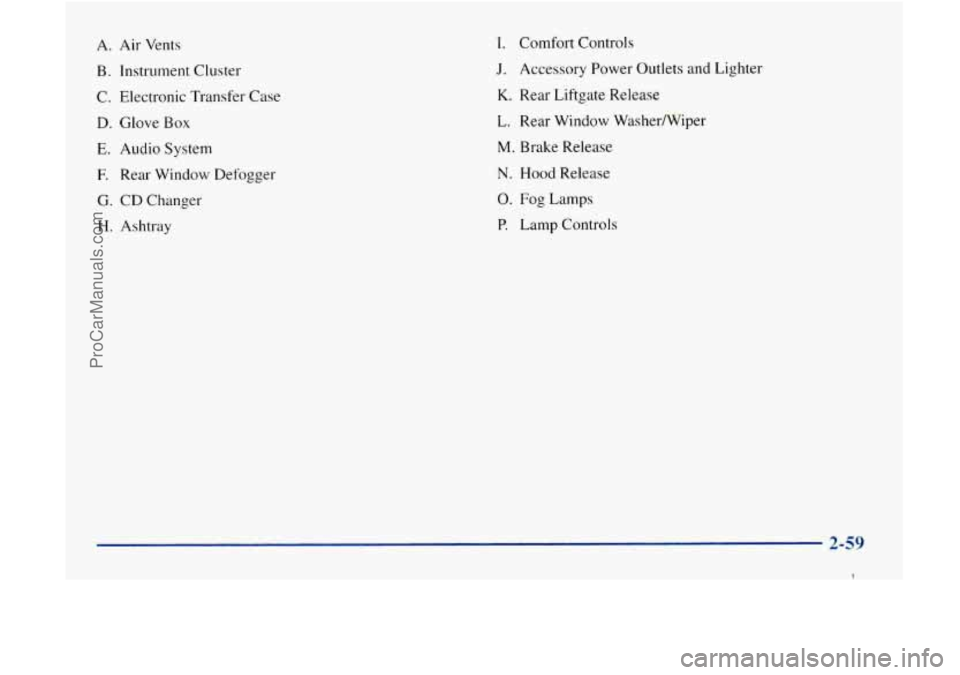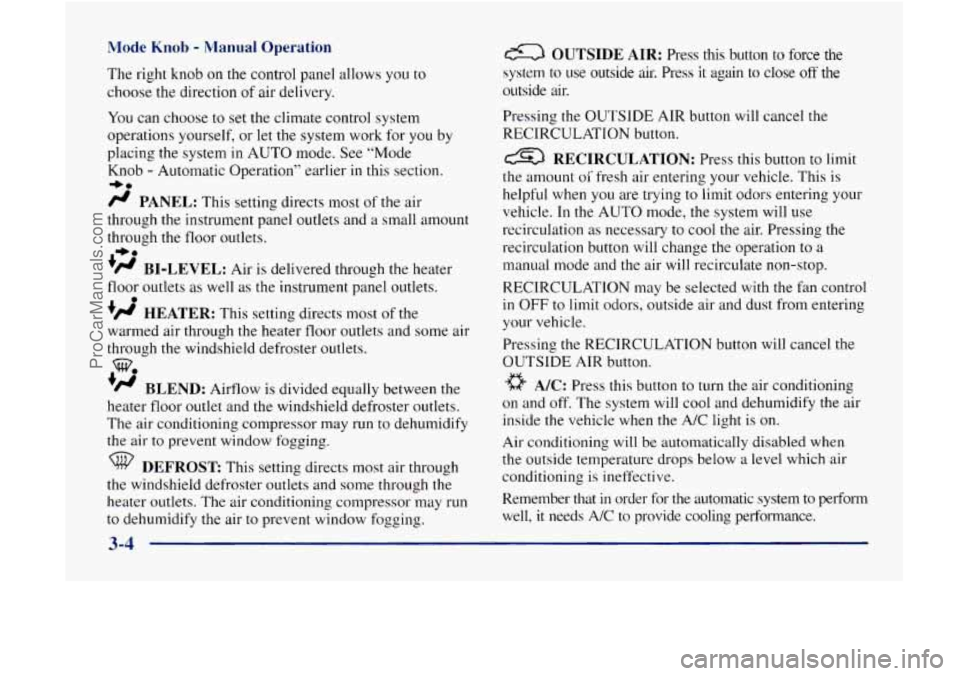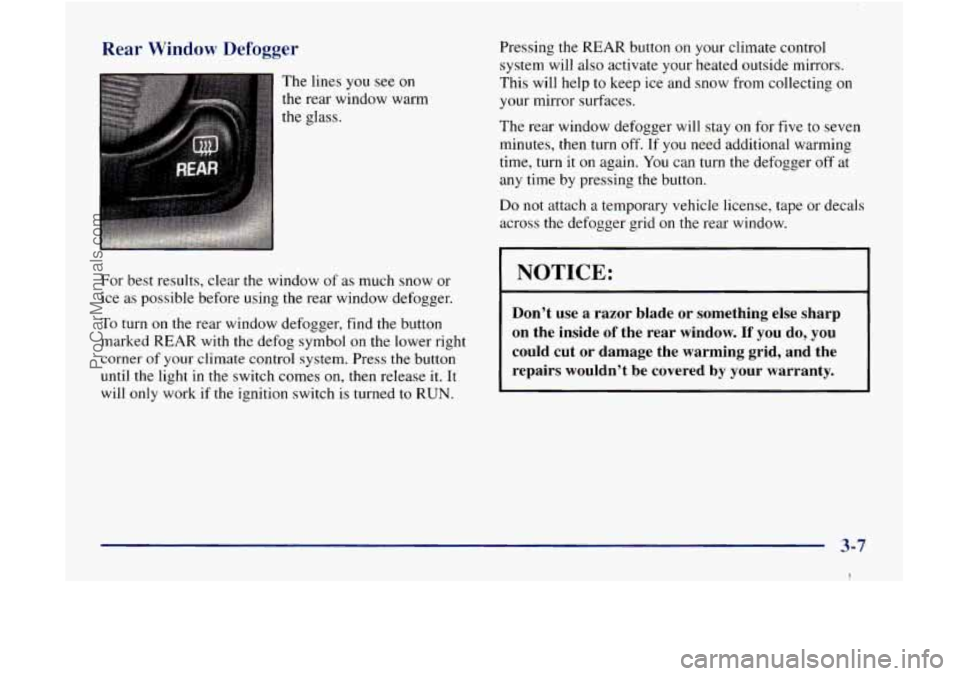1998 GMC ENVOY fog light
[x] Cancel search: fog lightPage 6 of 386

1
Vehicle Symbols
These are some of the symbols you tnay find on your vehicle.
For example.
these symbols
are used
on an
original battery:
POSSIBLE A
CAUTION
INJURY
PROTECT EYES BY
SHIELDING
CAUSTIC
ACID COULD
BATTERY
CAUSE
BURNS
AVOID
SPARKS
OR
FLAMES
SPARK
OR ,111,
COULD FLAME
EXPLODE BATTERY
These symbols
are important
for you and
your passenpel-s
whenever your vehicle
is
driven:
DOOR LOCK
UNLOCK
FA$TEll SEAT
BELTS SIGNALS
TURN
RUNNING
.':**o
DAYTIME LAMPS
*
FOG LAMPS $0
WINDSHIELD
WIPER
WINDSHIELD DEFROSTER
WINDOW
DEFOGGER
VENTILATING
i F,
FAN COOLANT
-
TEMP -
CHARGING I-1
BATTERY
SYSTEM
BRAKE
(a)
COOLANT a
ENGINE OIL w,
PRESSURE
ANTI-LOCK
(@)
BRAKES
Here are some
other symbols
you may see:
FUSE
P
LIGHTER m
HORN b
SPEAKER
b
FUEL p3
V
1
ProCarManuals.com
Page 99 of 386

The DRL system will make your high-beam headlamps
come
on at reduced brightness when:
Fog Lamps
the ignition is on,
the headlamp switch is in automatic headlamp
mode and
the parking brake is released.
When the DRL are on, only your high-beam headlamps
will be on. The taillamps, sidemarker and other lamps
won’t be on. The instrument panel won’t be lit up either.
When it begins to get dark, the high-beam headlamps
will automatically switch from DRL to the regular
low-beam headlamps.
When you turn
the headlamp switch off, the regular
low-beam headlamps will
go off, and your high-beam
headlamps will change to the reduced brightness
of DRL
provided it is not dark outside.
To idle your vehicle with
the DRL off, set the parking
brake. The DRL will stay off until
you release the
parking brake.
As with any vehicle, you should turn on the regular
headlamp system
when you need it. Use your fog lamps
for better vision in foggy or misty
conditions. Your low-beam headlamps or your parking
lamps must be on for your fog lamps to work.
The fog lamp switch is
on the instrument panel under
the lamps switch. Press
the switch to turn the fog lamps
on. Press the switch again to turn them
off. A light will
glow in
the switch when the fog lamps are on.
Remember,
fog lamps alone will not give off as much
light as your headlamps. Never use your fog lamps in
the dark without turning on your headlamps.
The
fog lamps will go off whenever your high-beam
headlamps come on. When the high beams
go off, the
fog lamps will come on again.
2-38
ProCarManuals.com
Page 120 of 386

A. Air Vents
B. Instrument Cluster
C. Electronic Transfer Case
D. Glove Box
E. Audio System
E Rear Window Defogger
G. CD Changer
H. Ashtray
1. Comfort Controls
J. Accessory Power Outlets and Lighter
K. Rear Liftgate Release
L. Rear Window Washerwiper
M. Brake Release
N. Hood Release
0. Fog Lamps
P. Lamp Controls
2-59
I
ProCarManuals.com
Page 136 of 386

Mode Knob - Automatic Operation
The right knob on the control panel allows you to
choose the direction of air delivery. When the system is
set for automatic operation, sensors will control the air
delivery mode.
Air will come primarily from the floor or
instrument panel outlets, with some air directed to the
windshield to prevent fogging.
When the system is in AUTO mode, the air conditioning
light will turn on, and the recirculation and outside air
lights turn
off. With the system in full auto control
(both the fan and mode knobs
in AUTO), you still have
the ability to override any function. However,
continually overriding the outside air or the
A/C
compressor will limit the ability of the system to cool
the vehicle quickly.
If you push a button for a function which is nor
available, the light next to that button will flash three
times to alert you that it’s not available.
To find your comfort zone, start with the
74°F (23 O C)
setting and allow about 20 minutes for the system to
adjust the temperature if necessary.
With the automatic setting, the
air conditioning compressor
automatically cycles when needed to cool the
air. In cold
weather, when the system senses the need for heat, the
airflow
will be directed out the floor outlets. As the interior temperature approaches the desired setting, the
blower speed will decrease. To maintain interior comfort,
the &ow will adjust between the instrument panel
air
outlets and floor outlets. On bright sunny days in cool
weather, the alrflow may come out
of the air conditioning
and floor outlets (bi-level mode) to maintain comfort and
prevent stuffiiess.
To avoid blowing cold
air in cold weather, the system will
delay turning on the fan until warm
air is available. The
length of delay depends on the outside
air temperature,
engine coolant temperature or the time since the engine was last started.
As the coolant warms up, the blower fan
speed will gradually increase and
air will flow from the
heater outlets, with some airflow to
the windshield to
prevent fogging under most normal conditions.
If your vehicle is sitting out on a warm day and you
have the fan set on AUTO, the air will first flow out of
the floor air outlets
for a few seconds. That is normal.
This is to expel hot air from the air outlets.
As the air is
cooled, the airflow will move through the
air
conditioning outlets.
Be careful not to put anything over the solar sensor
located around the center of the instrument panel.
This sensor is used by the automatic system to
regulate temperature.
3-3
I
ProCarManuals.com
Page 137 of 386

Mode Knob - Manual Operation
The right knob on the control panel allows you to
choose the direction
of air delivery.
You can choose to set the climate control system
operations yourself, or let the system work for you by
placing the system
in AUTO mode. See “Mode
Knob
- Automatic Operation” earlier in this section.
/J PANEL: This setting directs most of the air
through the instrument panel outlets and a small amount
through the floor outlets.
’@ BI-LEVEL: Air is delivered through the heater
floor outlets as well as the instrument panel outlets.
+# HEATER: This setting directs most of the
warmed air through the heater floor outlets and some air
through the windshield defroster outlets.
‘/J BLEND: Airflow is divided equally between the
heater floor outlet and the windshield defroster outlets.
The air conditioning compressor may run
to dehumidify
the air to prevent window fogging.
+0
-bo
0
WO
DEFROST This setting directs most air through
the windshield defroster outlets and some through the
heater outlets. The air conditioning compressor may
run
to dehumidify the air to prevent window fogging.
a OUTSIDE AIR: Press this button to force the
system to
use outside air. Press it again to close off the
outside air.
Pressing the
OUTSIDE AIR button will cancel the
RECIRCULATION button.
RECIRCULATION: Press this button to limit
the amount
oi’ fresh air entering your vehicle. This is
helpful when
you are trying to limit odors entering your
vehicle. In the AUTO mode, the system will use
recirculation as necessary to cool
the air. Pressing the
recirculation button will change the operation to
a
manual mode and the air will recirculate non-stop.
RECIRCULATION may be selected
with the fan control
in OFF to limit odors, outside air and dust from entering
your vehicle.
Pressing the RECIRCULATlON button will cancel the
OUTSIDE AIR button.
a A/C: Press this button to turn the air conditioning
on and off. The system will cool and dehumidify the air
inside the vehicle
when the A/C light is on.
Air conditioning will be automatically disabled when
the outside temperature drops below a level which air
conditioning is ineffective.
Remember that
in order for the automatic system to perform
well,
it needs A/C to provide cooling performance.
3-4
ProCarManuals.com
Page 138 of 386

Air Conditioning
On hot days, open the windows long enough to let hot
inside air escape. This reduces the time
it takes for your
vehicle to cool down. Then keep your windows closed
for the air conditioner to work its best.
Heating
For quick cool-down on very hot days, A/C should be
enabled with the temperature knob turned
to the left and
the OUTSIDE
AIR button should not be active. This
setting should be used to keep odors and/or dust from
entering the vehicle. For normal cooling on hot days,
use
A/C with the temperature knob turned to the left.
On cool but sunny days, use BI-LEVEL
A/C to deliver
warm air to the floor and cooler air to the instrument
panel outlets.
When the air conditioner is on, you may sometimes
notice slight changes
in your vehicle’s engine speed
and power.
This is normal because the system is
designed to cycle the compressor on and off to keep the
desired temperature. The heater
works best
if you keep your windows closed
while using it.
On cold days, use HEATER with the
temperature knob turned
to the right. BLEND is useful
in cool weather when
you have fog or ice on the
windshield
or side windows.
If you use the optional engine coolant heater before
starting your engine, your heating system will produce
warmer air faster to heat the passenger compartment in
cold weather. See “Engine Coolant Heater”
in the Index.
Ventilation System
For mild outside temperatures when little heating or
cooling is needed, use PANEL with the OUTSIDE
AIR
button enabled to direct outside air through your vehicle.
Airflow is through the instrument panel outlets.
Your vehicle’s ventilation system supplies outside air to
the inside
of your vehicle when it is moving. When the
vehicle is not moving, you can get outside air to flow
through by selecting
any mode and any fan speed.
3-5
!
ProCarManuals.com
Page 140 of 386

Rear Window Defogger
The lines you see on
the rear window warm
the glass.
For best results, clear the window of as much snow or
ice
as possible before using the rear window defogger.
To turn on the rear window defogger, find the button
marked REAR with the defog symbol
on the lower right
corner of your climate control system. Press
the button
until the light in the switch comes on, then release it. It
will only work
if the ignition switch is turned to RUN.
Pressing the REAR button on your climate control
system will also activate your heated outside mirrors.
This will help to keep ice and snow from collecting
on
your mirror surfaces.
The rear window defogger will stay on for five
to seven
minutes, then turn
off. If you need additional warming
time, turn it on again. You can turn the defogger off at
any time by pressing the button.
Do not attach a temporary vehicle license, tape or decals
across the defnqger grid on
the rear window.
NOTICE:
Don’t use a razor blade or something else sharp
on the inside of the rear window. If you do, you
could cut or damage the warming grid, and the
repairs wouldn’t be covered by your warranty.
3-7
I
ProCarManuals.com
Page 306 of 386

Name
RT TRN
RR PRK
TRL PRK
LT HDLP
RT HDLP
LT HI
RT HI
FR PRK
INT BAT
ENG
I
ECM B
ABS
ECM
1
HORN
BTS
I
BIU LP
IGN E
AIC
RAP
OXYSEN
Usage
Right Turn Signal Rear
Right Rear Parking Lamps
Trailer Park Lamps Left Headlamp
Right Headlamp
Left High Beam
Right High Beam
Front Parking Lamps
I/P Fuse Block Feed
Engine SensorsISolenoids, MAP,
CAM. PURGE, VENT
Engine Control Module, Fuel Pump,
Module, Oil Pressure
Anti-Lock Brake System
Engine Control Module Injectors Horn
Brake-Transmission Shift Interlock
Back-up
Lalllps
Engine
Air Conditioning
Retained Accessory Power
Oxygen Sensor
Name
IGN B
DRL
FOG LP
IGN
A
STUD #2
PARKLP
LR PRK
IGN C
HTDSEAT ATC
RRDFOG
HVAC
TRCHMSL
RR W/W
CRANK
LD LEV
HI BEAM
HAZLP
VECHMSL
HTDMIR
STOPLP
TBC
Usage
Column Feed, IGN 2, 3,4
Daytime Running Lamps
Fog Lamps
Starting and Charging IGN
I
Accessory Feeds, Electric Brake
Parking La~nps
Left Rear Parking Lamps Starter Solenoid, Fuel Pump. PRNDL
Heated Seat
Electronic Transfer Case
Rear Defogger
HVAC System
Trailer Center High Mount Stop Light
Rear Window Wiper
Clutch Switch, NSBU Switch
Electronic Load Leveling
HID Headlamps Hazard Lamps
Vehicle Center High
Mount Stop Lamp
Heated Mirror
Stoplamps
Truck Body Computer
6-59
1
ProCarManuals.com